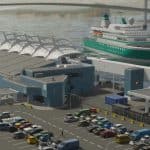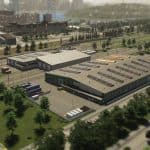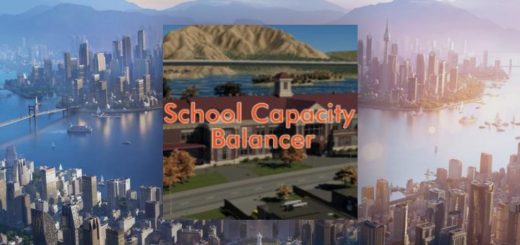








Cities Skylines 2: Public Transport Types
When starting a city development game, the first available public transport mode is typically buses. They’re a cost-effective and adaptable solution, and though heavily impacted by the city’s traffic conditions, they form the foundation of the early public transport network.
Maintenance of city buses is crucial, necessitating a Bus Depot. These buses come in two types: conventional fuel-powered buses and eco-friendly electric buses. To integrate electric buses into your city’s public transport, an upgrade to the bus depot will be mandatory to facilitate maintenance.
Notably, buses serve more than just the local citizens, they are also capable of transporting individuals from external connections. Upon setting up the Bus Depot, you have the ability to construct intercity bus lines. These intercity buses can additionally make stops at the bus station or even drop off and pick-up passengers from one or more standard bus stops.

Place either a Bus Stop Sign or Shelter on a road to determine where buses should pick up and drop off passengers
In most cities, taxis are an essential form of transportation, and the same holds true for Cities: Skylines II. Taxis function much like personal vehicles. In the early stages of the game, they not only transport passengers around the city but also bring new citizens who don’t have personal transportation.
Taxis offer immense flexibility as a public transport option due to their no-dependency on specific routes or lines. However, they do come with certain limitations. With their limited passenger capacity, they contribute to and can be hindered by the city’s traffic congestion.

Add a Taxi Depot to your city to provide citizens with taxi services
For taxi maintenance, a Taxi Depot is necessary. Initially, taxis can only collect passengers from designated taxi stands. Upon upgrading the Taxi Depot with a dispatch center, taxis gain the freedom to pick up passengers from anywhere within the city. To improve the taxi service’s eco-friendliness, electric taxis can replace traditional ones and help reduce noise and air pollution. The Taxi Depot must be upgraded to support electric taxis for this purpose.
As a mode of transportation, trains can carry substantial passenger and cargo capacities. Though the size of their infrastructure makes them better suited for intercity transport, local utilization is also possible. To implement train lines, a Rail Yard is required to manage train dispatch and maintenance while ensuring connectivity to the tracks. Constructing a train infrastructure involves significant initial costs, but the long-term benefits from the transport capacities make it a worthy investment.

The Rail Yard provides your city with both passenger and cargo trains
Train infrastructure offers dynamic track construction options, including two-way and double tracks, one-way tracks, bridges, tunnels, as well as elevated and cut-and-fill tracks that run below ground level. Trains and other rail transport vehicles can seamlessly navigate in both directions, making use of track switches established by merging two-way and double train tracks.
Train stations come with pre-installed tracks that instantly create track switches when connected with any other track variant, simplifying the overall track laying and connection process.

Train stations can be upgraded with additional platforms and connected to other forms of public transportation
As a light-rail alternative, trams provide increased adaptability when extending the public transportation network in a developing city. Integrating tram tracks into existing road infrastructure is made easy through the replace tool. Alternatively, separate tram tracks can be constructed to run directly on the terrain, allowing them to avoid other traffic altogether.

Run tram lines on roads or a dedicated network
To establish a tram network, a Tram Depot is necessary for dispatching and maintaining the tram fleet. Although the initial cost of implementing a tram network is higher than deploying a bus fleet, the benefits include quieter operation and reduced air pollution.
Tram construction is similar to roads and train tracks. They feature one-way and double tram tracks, with options for elevated tracks, bridges, cut-and-fill tracks, and tunnels.
Subways are a fast, high-capacity local public transport alternative. Despite their substantial initial investment in rapid transit infrastructure, their speed attracts many citizens who prioritize time-efficiency when calculating their commute. While subways can be constructed above ground or even on elevated tracks, they are most beneficial due to their minimal space requirements when built underground. The compact design of underground stop entrances allows them to fit seamlessly between buildings without occupying significant space.

An underground subway station doesn’t require much space and can easily fit between buildings
Just like trains, subways necessitate a Subway Yard to provide trains for the various routes. Subways leverage exclusive tracks, and passengers can reach trains through both underground and aboveground stations. Mirroring other rail systems, subways can have double and one-way tracks, with additional options for elevated and cut-and-fill tracks, bridges, and tunnels.
Water transportation presents the choice of passenger and cargo transportation. Ships have a high passenger capacity and can commute both within the city and between the city and Outside Connections. Intercity water transport needs access to the map peripherals via seaways and a connection from the harbors to these seaways.

A passenger harbor is a great addition to any waterfront city
Air transportation serves as a swift intercity transport choice for both passengers and cargo. While planes carry fewer passengers and cargo compared to ships and trains, their superior speed compensates for the smaller capacity.
Building airports does require extensive space, with the International Airport equating to the size of a small town! Based on the number of air transport lines implemented, airports can generate substantial traffic between the city and the airport. When positioning an airport, the projected landing and take-off zones are displayed at the ends of the building, providing an estimate of where restrictions on zoned building heights apply.

Airports limit the height of buildings in the landing and take-off zones to avoid collisions
Air transport lines need no supplementary infrastructure beyond the airports. Airports are linked to Outside Connections using the line tool, with airplanes commencing travel along these routes as soon as they are established.






